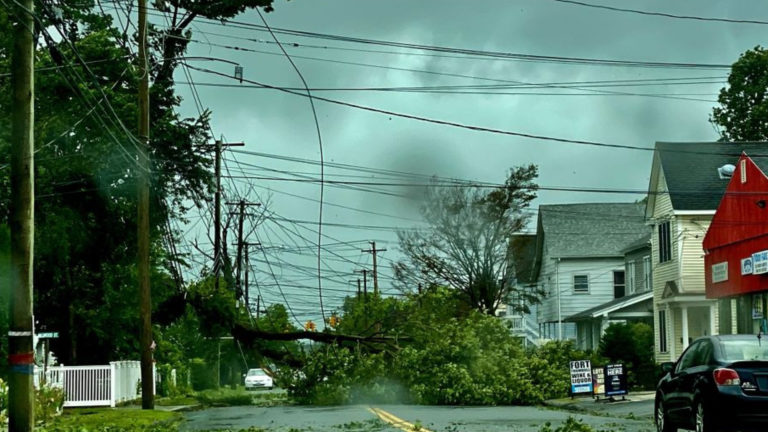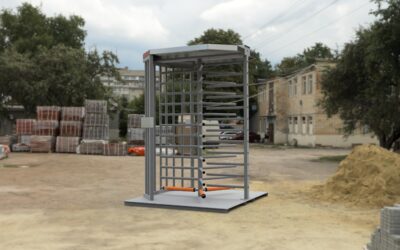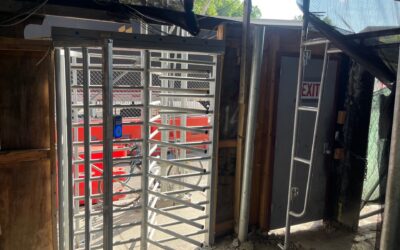At a Glance: Turnstiles Help Control Access Even in Power Outages
- Tropical Storm Isaias recently created widespread power outages for most of Connecticut
- Power outages create risky situations for those that depend on access control systems for security
- Electric operation turnstiles and gates rely on a steady flow of electricity to work properly
- All electric turnstiles and ADA compliant gates are configured as either fail safe or fail secure
- Fail safe and fail secure configurations dictate whether a turnstile will lock (fail secure) or unlock (fail safe) when power is cut

Some destruction right here in Milford, Connecticut where our Hayward Turnstiles facilities are located.
Tropical Storm Isaias Leaves Behind a Wake of Destruction and a Learning Opportunity
Early this week on Tuesday, August 4th, Tropical Storm Isaias rapidly made its way up the eastern seaboard towards Connecticut. While Isaias was technically downgraded to a tropical storm during its journey up the east coast, it spared the Northeast no mercy. Supplemented by an unusually strong August jet stream, Isaias generated frequent gusts from 60 to 70 miles per hour causing numerous downed trees and destroyed power lines.
Though originally on a direct path with Connecticut, Isaias ended up shifting northwest towards New York and Pennsylvania. Because of this, Connecticut experienced the bulk of the strong winds from the southeast side of the storm cell. These strong winds in excess of 66 miles per hour caused a state-wide blackout with over 700,000 without power. In fact, the damage from Isaias is so widespread in our little state that the federal government has approved a presidential emergency declaration for the state of Connecticut.
In the wake of the storm, all Hayward Turnstiles facilities–along with most of Connecticut–were left without power, internet, or even cell service until early on the 7th of August. This experience forced a pause in our operations because even working from home was not possible with all of our servers and critical infrastructure offline.
Tropical Storm Isaias was a wake up call for the normally uneventful Northeast, proving that electricity is a luxury that can be taken away at a moments notice with very little warning. We now understand that being prepared for the aftermath of a storm is just as important as being prepared for the storm itself. This situation is what inspired me to write about this week’s topic: how turnstiles react to power outages. In this article, we will go over what happens to your turnstile access control system your facility loses power or encounters an emergency situation and what options you have.
Unforeseen Risks Affecting Access Control
Power outages create unforeseen risks to your access control system. Whether its from high winds, a storm, ice, a car accident, fallen trees, or more, power outages can happen at any time without warning.
Access control systems usually rely on a steady flow of electricity to function properly. For instance, video cameras, credential readers, monitors, and electronically operated turnstiles all rely on electrical power. Without electrical power, most access control systems cannot function properly. Even just a momentary lapse in power can prove dangerous to high-risk facilities like prisons and borders that use access control systems for their entrance security. This is why it is important to understand the different ways a turnstile or security gate may act when electrical power is lost. Luckily, our Hayward Turnstiles products are all built with safety measures in place for when power is lost, so you will not be left entirely in the dark.
What is the Difference Between Fail Safe and Fail Secure?

There are only two ways an electric turnstile (or electronic ADA gate) can be programmed to act when a power outage or emergency occurs; the turnstile will either unlock or it will lock. These two options are called fail safe and fail secure:
- Fail Safe: When electrical power is cut from a turnstile or ADA gate either in an emergency situation or a power outage, the turnstile or ADA gate will immediately unlock to allow free passage until power is restored.
- Fail Secure: When electrical power is cut from a turnstile or ADA Gate either in an emergency situation or a power outage, the turnstile or ADA gate will immediately lock to prevent access until power is restored.
A clever mix of gravity, engineering, and mechanism placement are what allows these units to lock and unlock even after power is cut from their internal locking solenoids, making them fool-proof and very dependable. It is up to our customers to decide whether they want their electric access control products to be fail safe or fail secure, but read on to the next section to learn about what types of applications fail safe and fail secure are best for.
When to Use Fail Safe and When to Use Fail Secure
Almost every electronically operated turnstile or ADA gate that we specify for customers is fail safe. It is generally considered a best practice to provide safe and easy exit options to people inside your facility when there is an emergency or a blackout. Further, most towns and states have ordinances that require entrance control devices provide safe exit in the event of an emergency or power outage. For example, many of our university clients specify fail safe turnstiles so that if there ever was a fire drill or a loss of power on the campus, students would not get trapped in the various buildings.
Fail secure turnstiles and gates are much more rare. They do not pass code for most installments because of the locking nature, so they are almost never used in public installments unless there are other exit options right next to them. Fail secure does serve a vital purpose for some applications, though. For instance, many of our detention center clients would find themselves in a very bad situation if their full height high security turnstiles unlocked all of the sudden and let their inmates out because of a quick loss of power. In these situations, security takes priority over safety. Many data centers, power plants, government and military facilities, and more all benefit from using fail secure functionality with their electrically operated turnstiles.
In the end, it truly comes down to what kind of situation arises after power is lost. If you would need people to exit your facility easily during an emergency or a power outage, then fail safe is your option of choice. But, if you want to make sure nobody gets in or out when power is lost, you should go with fail secure for your facility.
Conclusion
When deciding whether your turnstile should be configured as fail safe or fail secure, you should first think about what you would like to happen in your facility when the power goes out. Thinking ahead and creating a game plan for these types of events will help you choose the correct turnstiles for your security needs and access control applications. As always, our access control specialists are always just a click or a call away to help walk you through your project from design all the way to installation. We would be happy to assist you with your next project.
Still Unsure About Your Project? Reach Out Below:




